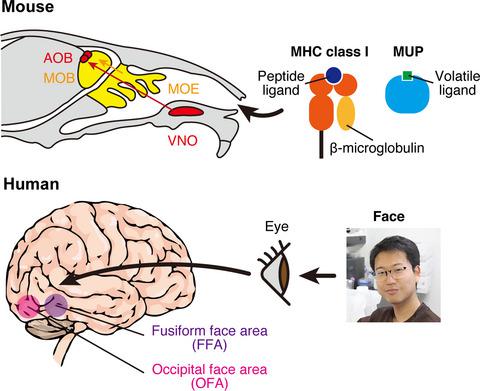当前位置:
X-MOL 学术
›
Dev. Growth Differ.
›
论文详情
Our official English website, www.x-mol.net, welcomes your feedback! (Note: you will need to create a separate account there.)
Diverse sensory cues for individual recognition
Development, Growth & Differentiation ( IF 2.5 ) Pub Date : 2020-10-28 , DOI: 10.1111/dgd.12697 Myung Chung 1 , Mu-Yun Wang 1 , Ziyan Huang 1 , Teruhiro Okuyama 1, 2
Development, Growth & Differentiation ( IF 2.5 ) Pub Date : 2020-10-28 , DOI: 10.1111/dgd.12697 Myung Chung 1 , Mu-Yun Wang 1 , Ziyan Huang 1 , Teruhiro Okuyama 1, 2
Affiliation

|
To be social, the ability to recognize and discriminate conspecific individuals is indispensable in social animals, including primates, rodents, birds, fish, and social insects which live in societies or groups. Recent studies using molecular biology, genetics, in vivo and in vitro physiology, and behavioral neuroscientific approaches have provided detailed insights into how animals process and recognize the information of individuals. Here, we review the most distinct sensory modalities for individual recognition in animals, namely, olfaction and vision. In the case of rodents, two polymorphic gene complexes have been identified in their urine as the key and essential pheromonal components for individual recognition: the major histocompatibility complex (MHC) and the major urinary protein (MUP). Animals flexibly utilize MHC and/or MUP, which are detected by the main olfactory epithelium (MOE) and/or the vomeronasal organ (VNO) for various types of social recognition, such as strain recognition, kin recognition, and individual recognition. In contrast, primates, including humans, primarily use facial appearance to identify others. Face recognition in humans and other animals is naturally unique from genetic, cognitive, developmental, and functional points of view. Importantly note that nurture effects during growth phase such as social experience and environment can also shape and tune this special cognitive ability, in order to distinguish subtle differences between individuals. In this review, we address such unique nature and nurture mechanisms for individual recognition.
中文翻译:

用于个体识别的多种感官线索
对于社会性而言,识别和区分同种个体的能力对于社会性动物是必不可少的,包括生活在社会或群体中的灵长类动物、啮齿动物、鸟类、鱼类和社会性昆虫。最近使用分子生物学、遗传学和体内的研究体外生理学和行为神经科学方法为动物如何处理和识别个体信息提供了详细的见解。在这里,我们回顾了动物个体识别最独特的感官方式,即嗅觉和视觉。就啮齿类动物而言,已在其尿液中鉴定出两种多态性基因复合物作为个体识别的关键和必需信息素成分:主要组织相容性复合物 (MHC) 和主要尿蛋白 (MUP)。动物灵活地利用 MHC 和/或 MUP,由主要嗅觉上皮 (MOE) 和/或犁鼻器官 (VNO) 检测到,用于各种类型的社会识别,例如品系识别、亲属识别和个体识别。相比之下,灵长类动物,包括人类,主要是利用面部特征来识别他人。从遗传、认知、发育和功能的角度来看,人类和其他动物的人脸识别自然是独一无二的。重要的是要注意,成长阶段的养育影响,如社会经验和环境,也可以塑造和调整这种特殊的认知能力,以区分个体之间的细微差异。在这篇评论中,我们讨论了这种独特的性质和个人识别的培养机制。以区分个体之间的细微差别。在这篇评论中,我们讨论了这种独特的性质和个人识别的培养机制。以区分个体之间的细微差别。在这篇评论中,我们讨论了这种独特的性质和个人识别的培养机制。
更新日期:2020-12-21
中文翻译:

用于个体识别的多种感官线索
对于社会性而言,识别和区分同种个体的能力对于社会性动物是必不可少的,包括生活在社会或群体中的灵长类动物、啮齿动物、鸟类、鱼类和社会性昆虫。最近使用分子生物学、遗传学和体内的研究体外生理学和行为神经科学方法为动物如何处理和识别个体信息提供了详细的见解。在这里,我们回顾了动物个体识别最独特的感官方式,即嗅觉和视觉。就啮齿类动物而言,已在其尿液中鉴定出两种多态性基因复合物作为个体识别的关键和必需信息素成分:主要组织相容性复合物 (MHC) 和主要尿蛋白 (MUP)。动物灵活地利用 MHC 和/或 MUP,由主要嗅觉上皮 (MOE) 和/或犁鼻器官 (VNO) 检测到,用于各种类型的社会识别,例如品系识别、亲属识别和个体识别。相比之下,灵长类动物,包括人类,主要是利用面部特征来识别他人。从遗传、认知、发育和功能的角度来看,人类和其他动物的人脸识别自然是独一无二的。重要的是要注意,成长阶段的养育影响,如社会经验和环境,也可以塑造和调整这种特殊的认知能力,以区分个体之间的细微差异。在这篇评论中,我们讨论了这种独特的性质和个人识别的培养机制。以区分个体之间的细微差别。在这篇评论中,我们讨论了这种独特的性质和个人识别的培养机制。以区分个体之间的细微差别。在这篇评论中,我们讨论了这种独特的性质和个人识别的培养机制。



























 京公网安备 11010802027423号
京公网安备 11010802027423号